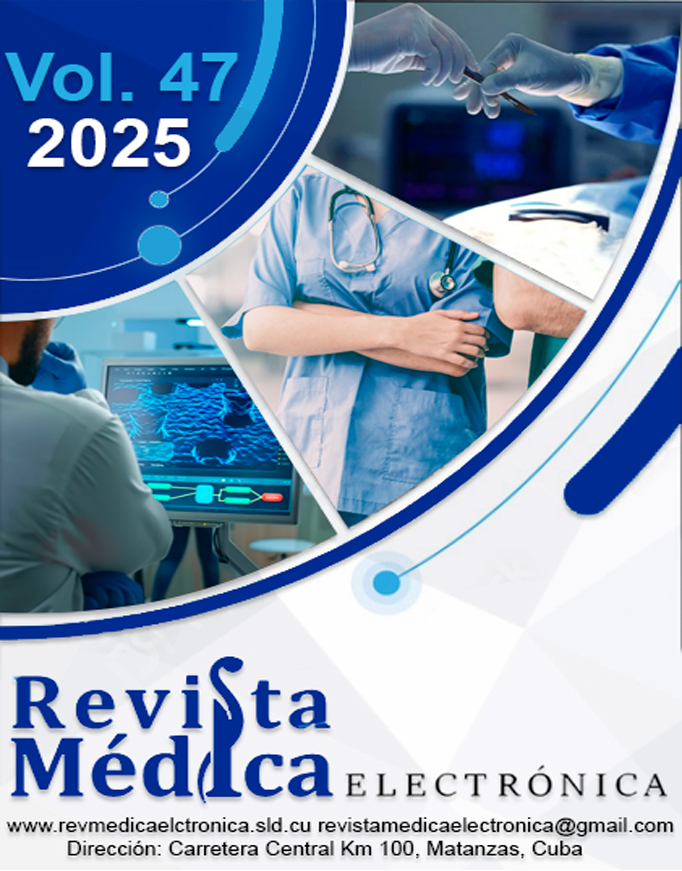Evaluation of the effect of an Aloe vera L. nutraceutical on muscle mass
Keywords:
muscle mass, Aloe vera L., nutraceutical, vegetable proteins, strength exercisesAbstract
Introduction: The loss of muscle mass associated with aging can negatively affect health and quality of life.
Objective: To evaluate the effects of an Aloe vera L. nutraceutical and strength exercises on muscle mass in adults aged 50-60 years.
Methods: A quasi-experimental study was conducted with 113 participants divided into four groups: nutraceutical plus strength training, strength training, nutraceutical consumption, and a control group. The intervention lasted six months. Changes in body composition were assessed using bioimpedance analysis, and sleep, hydration, and dietary habits were monitored.
Results: The combination of nutraceutical and exercise resulted in a significant 4% increase in muscle mass (p<0.000), superior to exercise alone 2% (p<0.000) or nutraceutical alone (not significant). All groups showed improvements in other body composition variables (weight, percent of body fat, and body mass index). Adherence to healthy habits contributed positively in all groups. Two-way ANOVA revealed significant effects of nutraceutical (F=31.9; p=0.000) and exercise (F=102.2; p=0.000) on muscle mass, with a significant synergistic interaction between strength exercise and nutraceutical consumption (F=60.3; p=0.000).
Conclusions: The results suggest that the combination of supplementation with the nutraceutical Aloe vera L. and resistance exercise is an effective strategy to improve muscle mass in middle-aged adults. Further studies are required to confirm these findings and explore the underlying mechanisms.
Downloads
References
1. Kaur S, Bains K. Aloe Barbadensis Miller (Aloe Vera). Int J Vitam Nutr Res. 2024;94(3-4):308-21. DOI: 10.1024/0300-9831/a000797.
2. Gao Y, Kuok KI, Jin Y, et al. Biomedical applications of Aloe vera. Crit Rev Food Sci Nutr. 2019;59(supl 1):S244-56. DOI: 10.1080/10408398.2018.1496320.
3. Rezazadeh-Bari M, Najafi-Darmian Y, Alizadeh M, et al. Numerical optimization of probiotic Ayran production based on whey containing transglutaminase and Aloe vera gel. J Food Sci Technol. 2019;56:3502-12. DOI: 10.1007/s13197-019-03841-3.
4. Lambert T. Técnicas curativas del aloe vera: todo lo que necesitas saber para cuidarte de una forma natural con aloe vera. Barcelona: Robinbook; 2021.
5. Garcia Moreira V, Perez M, Alves Lourenço R. Prevalence of sarcopenia and its associated factors: the impact of muscle mass, gait speed, and handgrip strength reference values on reported frequencies. Clinics. 2019;74:e477. DOI: 10.6061/clinics/2019/e477.
6. Sánchez-Castellano C, Martín-Aragón S, Vaquero-Pinto N, et al. Prevalencia de sarcopenia y características de los sarcopénicos en pacientes mayores de 80 años ingresados por fractura de cadera. Nutr Hosp. 2019;36(4):813-8. DOI: 10.20960/nh.02607.
7. Villanueva-Guerrero O, Gadea-Uribarri H, Villavicencio Álvarez VE, et al. Relationship between Interlimb Asymmetries and Performance Variables in Adolescent Tennis Players. Life. 2024;14(8):959. DOI: 10.3390/life14080959.
8. Mainer-Pardos E, Villavicencio Álvarez VE, Moreno-Apellaniz N, et al. Effects of a neuromuscular training program on the performance and inter-limb asymmetries in highly trained junior male tennis players. Heliyon. 2024;10(5):e27081. DOI: 10.1016/j.heliyon.2024.e27081.
9. López-Gamboa Y, Márquez-Ibarra AA. Formulación de un nutracéutico de Aloe vera L. para la ganancia de masa muscular. Revista UGC [Internet]. 2024 [citado 05/11/2024];2(3):46-52. Disponible en: https://universidadugc.edu.mx/ojs/index.php/rugc/article/view/53
10. Beaudart C, Dawson A, Shaw SC, et al. Nutrition and physical activity in the prevention and treatment of sarcopenia: systematic review. Osteoporos Int. 2017;28:1817-33. DOI: 10.1007/s00198-017-3980-9.
11. Kim H, Suzuki T, Saito K, et al. Effects of exercise and tea catechins on muscle mass, strength and walking ability in community‐dwelling elderly Japanese sarcopenic women: a randomized controlled trial. Geriatr Gerontol Int. 2012;13(2):458-65. DOI: 10.1111/j.1447-0594.2012.00923.x.
12. Solano García W, Carazo Vargas P. Efecto de intervenciones con ejercicio o suplementación sobre la masa muscular de personas mayores con sarcopenia. Un meta-análisis. Pens Mov Rev Cienc Ejerc Salud. 2019;17(1):e34449. DOI: 10.15517/pensarmov.v17i1.34449.
13. Espinel-Bermúdez MC, Sánchez-García S, García-Peña C, et al. Associated factors with sarcopenia among Mexican elderly: 2012 National Health and Nutrition Survey. Rev Med Inst Mex Seguro Soc [Internet]. 2018 [citado 05/11/2024];56(Supl 1):S46-53. https://pubmed.ncbi.nlm.nih.gov/29624960/
14. Choi YI, Chung JW, Park DK, et al. Sarcopenia is Independently Associated with an Increased Risk of Peptic Ulcer Disease: A Nationwide Population-Based Study. Medicina. 2020;56(3):121. DOI: 10.3390/medicina56030121.
15. Urquiaga I, Echeverria G, Dussaillant C, et al. Origin, components and mechanisms of action of the Mediterranean diet. Rev méd Chile. 2017;145(1):85-95. DOI: 10.4067/s0034-98872017000100012.
16. Chiang FY, Chen JR, Lee WJ, et al. Effects of milk or soy milk combined with mild resistance exercise on the muscle mass and muscle strength in very old nursing home residents with sarcopenia. Foods. 2021;10(11):2581. DOI: 10.3390/foods10112581.
17. Geniole SN, Bird BM, McVittie JS, et al. Is testosterone linked to human aggression? A meta-analytic examination of the relationship between baseline, dynamic, and manipulated testosterone on human aggression. Horm Behav. 2020;123:104644. DOI: 10.1016/j.yhbeh.2019.104644.
18. Alzate Yepes T. La obesidad sarcopénica en los adultos mayores. Perspect Nut Hum. 2020;22(2):133-6. DOI: 10.17533/udea.penh.v22n2a01.
19. Wing RR, Lang W, Wadden TA, et al. Benefits of modest weight loss in improving cardiovascular risk factors in overweight and obese individuals with type 2 diabetes. Diabetes care. 2011;34(7):1481-6. DOI: 10.2337/dc10-2415.
20. Bauce G. Índice de masa corporal, peso ideal y porcentaje de grasa corporal en personas de diferentes grupos etarios. Rev Digit Postgrado [Internet]. 2022 [citado 05/11/2024];11(1):e331. http://saber.ucv.ve/ojs/index.php/rev_dp/article/view/22824
21. Howe LP, Read PJ, Waldron M. Hipertrofia muscular: revisión narrativa de los principios del entrenamiento para el incremento de la masa muscular. Entren Fuerza Acond J NSCA Spain [Internet]. 2018 [citado 05/11/2024];7:16-28. https://dialnet.unirioja.es/servlet/articulo?codigo=6460028
22. Guillermón Escudero C, Soriano JM, Diago Galmés A. Ingesta proteica en mujeres posmenopáusicas residentes en la comunidad y su relación con la sarcopenia. Nutr Hosp. 2021;38(6):1209-16. DOI: 10.20960/nh.03690.
23. Grgic J, Garofolini A, Orazem J, et al. Effects of resistance training on muscle size and strength in very elderly adults: a systematic review and meta-analysis of randomized controlled trials. Sports Med. 2020;50(11):1983-99. DOI: 10.1007/s40279-020-01331-7.
24. Serra-Prat M, Lorenzo I, Palomera E, et al. Total body water and intracellular water relationships with muscle strength, frailty and functional performance in an elderly population. A cross-sectional study. J Nutr Health Aging. 2019;23(1):96-101. DOI: 10.1007/s12603-018-1129-y.
25. Salas-Salvadó J, Maraver Eizaguirre F, Rodríguez-Mañas L, et al. Importancia del consumo de agua en la salud y la prevención de la enfermedad: situación actual. Nutr Hosp. 2020;37(5):1072-86. DOI: 10.20960/nh.03160.
Downloads
Published
How to Cite
Issue
Section
License
Copyright (c) 2025 Revista Médica Electrónica (Medical Electronic Journal)

This work is licensed under a Creative Commons Attribution-NonCommercial 4.0 International License.
All content published in this journal is Open Access, distributed under the terms of the CC BY-NC 4.0 License.
It allows:
- Copy and redistribute published material in any medium or format.
- Adapt the content.
This will be done under the following terms:
- Attribute the authors' credits and indicate whether changes were made, in which case it must be in a reasonable way.
- Non-commercial use.
- Recognize the journal where it is published.
The copyrights of each article are maintained, without restrictions.






